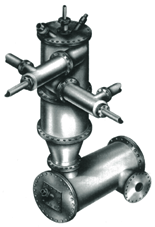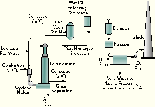


A washing machine uses centrifugal force to separate water from clothes by spinning the laundry at high speed. The Cyclone Melting System works in much the same manner. CMS spins molten mixed waste at high-speed, slinging the material out to the walls of the chamber, separating gas from molten glass. The resulting product is solid glass form that a is in non-hazardous suitable for storing landfills, processing into recycling, or glass products.
Vortec Corporation began developing CMS vitrification technology in the 1980s for treating wastes and manufacturing glass. In 1987, the U.S. Department of Energy began investigating the possibility of using CMS to vitrify mixed wastes. In 1988, a pilot plant was constructed at the University of Pittsburgh Applied Research Center to demonstrate CMS vitrification capabilities. The facility treats 15 tons of waste a day.
 In a commercial application, Ormet Primary Aluminum
Corporation has been using CMS to recycle spent aluminum pot liners contaminated with
cyanide and flouride. CMS oxidizes and vitrifies the liners into a glass material that can
be used as a recycled material by glass and tile manufacturers.
In a commercial application, Ormet Primary Aluminum
Corporation has been using CMS to recycle spent aluminum pot liners contaminated with
cyanide and flouride. CMS oxidizes and vitrifies the liners into a glass material that can
be used as a recycled material by glass and tile manufacturers.
Vortec is preparing for a commercial-scale demonstration of hazardous and radioactive material vitrification using CMS at DOE's Gaseous Diffusion Plant in Paducah, Kentucky. DOE's Morgantown Energy Technology Center in West Virginia is administering the project, which is sponsored by the DOE Office of Science and Technology. A 30-day demonstration will take place in June of 1997, after construction of an on-site demonstration plant is completed. At full operation, CMS should allow the Paducah Site to treat approximately 25 tons of contaminated material daily.
At Paducah, there is approximately 15,300,000 pounds of mixed waste in storage. The waste consists of soil, concrete, scrap metal, plastics, and other materials that are suitable for vitrification by CMS. The wastes are stored in drums and are contaminated with polychlorinated biphenyls, Resource Conservation and Recovery Act metals, hazardous organics, and low-level radionuclides. Paducah's ability to store this waste is at or near maximum capacity, and there are no treatment or disposal facilities on the site. DOE hopes to avoid building expensive new storage facilities by vitrifying the waste into a stable glass material that can be disposed of in landfills.
 CMS has the
ability to simultaneously treat organic contaminants, heavy metals, and
radionuclide-contaminated waste. The treatment process can be run in a continuous feed or
batch mode. The system consists of a patented heating device and specially designed
components that vaporize the water and oxidize volatile organic contaminants to form the
glass product. CMS is able to run off several different fuel types, including pulverized
coal, coal slurries, natural gas, fuel oil, and petrocoke.
CMS has the
ability to simultaneously treat organic contaminants, heavy metals, and
radionuclide-contaminated waste. The treatment process can be run in a continuous feed or
batch mode. The system consists of a patented heating device and specially designed
components that vaporize the water and oxidize volatile organic contaminants to form the
glass product. CMS is able to run off several different fuel types, including pulverized
coal, coal slurries, natural gas, fuel oil, and petrocoke.
CMS accepts wastes in both dry and slurry form. The waste first enters a precombustor where water is vaporized and organic contaminants are partially oxidized. Next, the waste travels into a preheater where it is combined with fuel and glass-making ingredients. A counter rotating vortex combustor is the next stop in the treatment process, where temperatures can exceed 3,000 degrees Fahrenheit. At this point, volatile organics are completely burned and inorganic materials are melted.
The molten mixture then moves into the device that gave CMS its name, the cyclone melter. Here, the mixture is spun at high speed, throwing the molten glass to the outside walls of the chamber through centrifugal force. After leaving the cyclone melter, the gases and molten glass enter a separator. The molten glass exits here and is cooled, but the trip isn't over for the gases yet. They continue on to a recuperator for recycling of heat back into the precombustor before exiting the system through a standard pollution control system.
In addition to DOE's wide variety of mixed wastes, CMS can also be used to treat many commercial wastes, from flyash to hospital and medical wastes.
The CMS unit and all of its subsystems are designed to be easily transportable, so when remediation is finished, the plant can be dismantled and moved to another site.
![]()
![]()
![]()